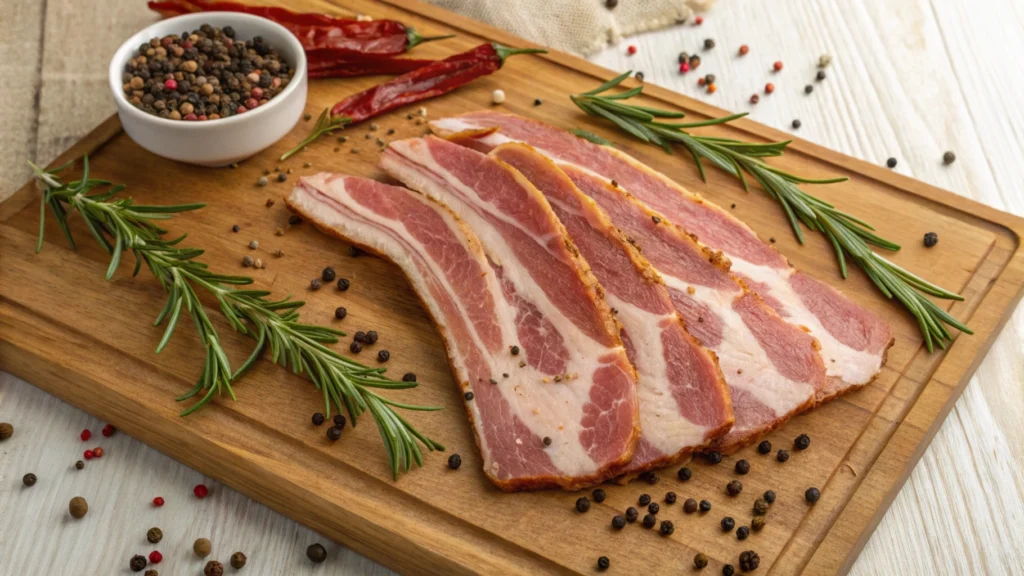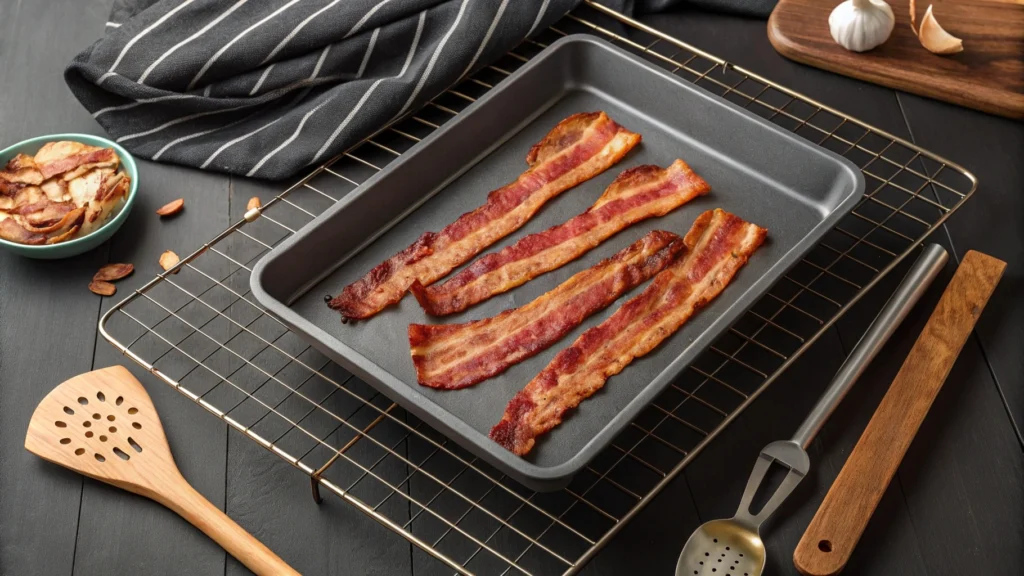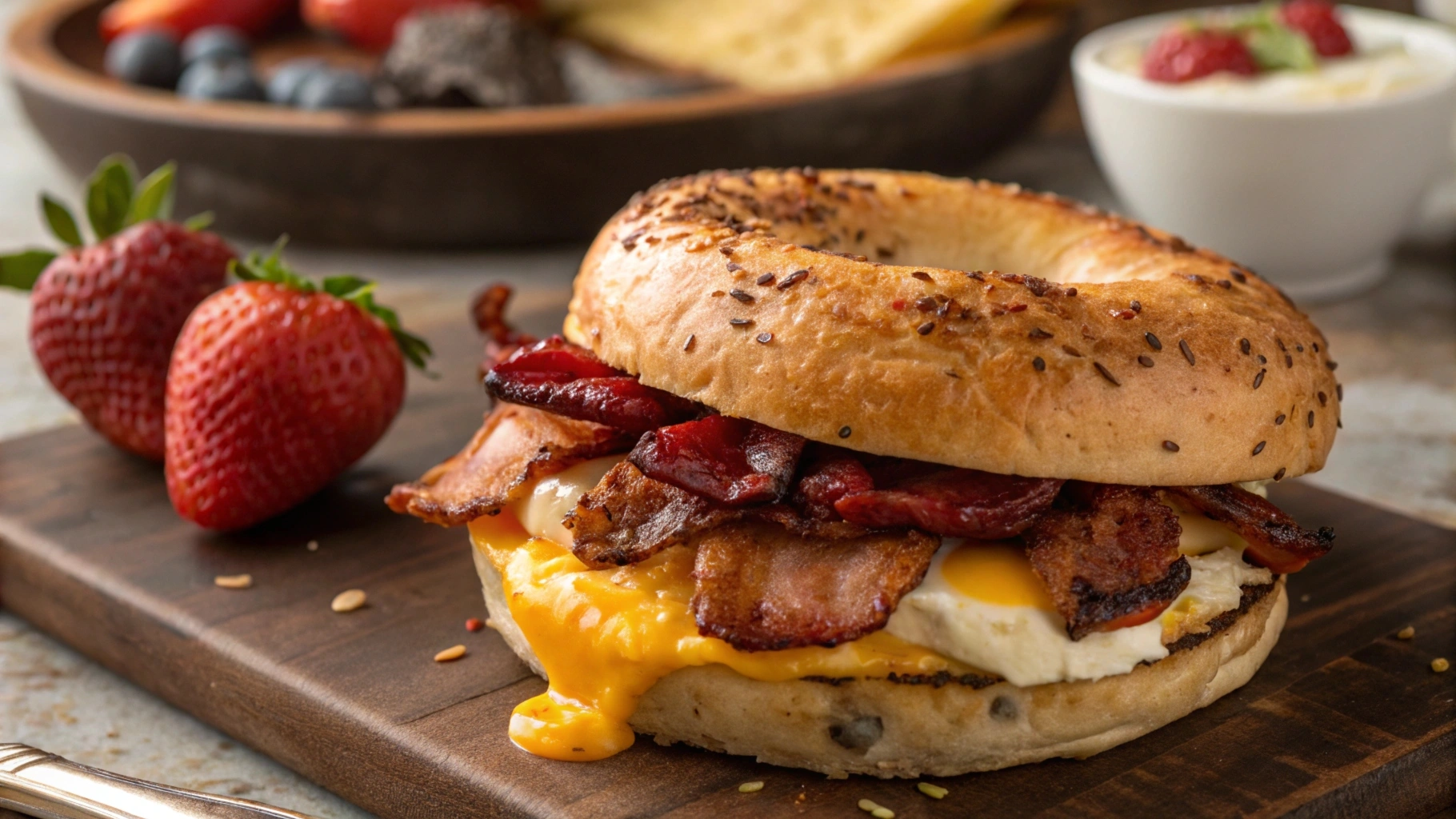Beef bacon is a flavorful, versatile option that’s been making waves in kitchens around the world. Whether you’re preparing a hearty breakfast, a savory lunch, or an indulgent dinner, mastering the art of cooking beef bacon can elevate your culinary game. In this guide, we’ll dive into the essentials, from understanding what beef bacon is to exploring various cooking methods and creative recipes. Whether you’re new to beef bacon or looking to refine your technique, this guide covers everything you need to know.
Let’s start with the basics and explore what makes beef bacon so unique.
What Is Beef Bacon?
What Is Beef Bacon Made Of?
Beef bacon is derived from the beef belly, a cut similar to where traditional bacon comes from in other meats. This flavorful and fatty section of beef is cured and sometimes smoked to achieve a rich, savory taste. Unlike other types of bacon, beef bacon brings a hearty, meaty flavor that pairs well with a wide range of dishes.
How Is Beef Bacon Prepared?
The preparation of beef bacon involves curing the beef belly with a blend of salt, sugar, and spices. After curing, it’s often smoked for added depth, though some varieties are left unsmoked for a purer beef flavor. The process ensures that beef bacon develops its signature texture and taste.
The Rise of Beef Bacon in Modern Cuisine
As people explore alternatives to traditional bacon, beef bacon has gained popularity for its bold taste and unique texture. It’s celebrated in diverse culinary traditions, offering a rich option for those seeking something different. From breakfast platters to gourmet recipes, beef bacon has carved a niche for itself in modern kitchens.
Preparing to Cook Beef Bacon
Cooking beef bacon starts with proper preparation to ensure every slice turns out irresistibly delicious. From choosing the perfect cut to having the right tools on hand, these foundational steps will set you up for success.

Selecting the Best Cuts for Beef Bacon
When selecting beef bacon, look for cuts with even marbling. The beef belly is the prime choice because of its balance between fat and meat, which creates that signature crispiness. Some variations may use brisket or other fatty cuts, but the belly remains the gold standard.
For a richer flavor, consider grass-fed beef bacon, which offers natural depth and complexity. Whether purchasing pre-sliced bacon or a whole slab, ensure the meat has a fresh, vibrant appearance and minimal discoloration.
Tools and Equipment Needed
Having the right tools is essential for achieving perfect results:
- A heavy skillet: Cast iron is best for even heat distribution.
- Oven-safe baking sheet: Lined with parchment paper for easy cleanup.
- Tongs: For flipping and removing the bacon without tearing it.
- Meat thermometer: Ensures precise cooking, especially for whole cuts.
Investing in a quality air fryer can also elevate your cooking options, as it produces a crispy texture with less grease.
Seasoning Options and Marinades
Though beef bacon is often seasoned during the curing process, adding your own flavors can take it to the next level. Sprinkle paprika, garlic powder, or black pepper for a smoky kick, or try a honey-soy glaze for a sweet-and-savory twist. Marinate whole slabs overnight for maximum flavor absorption before cooking.
Cooking Beef Bacon: Methods and Techniques
With preparation complete, it’s time to explore the best ways to cook beef bacon. Each method has its charm, so try them all to discover your favorite.
Oven-Baked Beef Bacon
Why bake it? Baking allows for even cooking and less mess. Preheat your oven to 400°F (200°C) and line a baking sheet with parchment paper. Lay the slices flat in a single layer, ensuring they don’t overlap.
Bake for 15–20 minutes, flipping the slices halfway for even browning. For extra crispness, use a wire rack to elevate the bacon, letting the fat drip below.
Pro tip: Use this method to prepare large batches of beef bacon effortlessly.
Pan-Frying Beef Bacon
Pan-frying creates a crispy, caramelized texture. Start by placing the bacon in a cold skillet and gradually heat to medium. This slow approach renders the fat evenly, preventing burning.
Flip the slices occasionally and cook until they reach your desired doneness usually 8–12 minutes. Be cautious of splattering grease by using a splatter screen.
Grilling Beef Bacon
If you crave smoky flavors, grilling is the way to go. Preheat your grill to medium heat and lightly oil the grates to prevent sticking. Lay the strips across the grates and cook for 3–5 minutes per side.
For thicker cuts, use indirect heat to avoid charring the edges while undercooking the center. The grill also works wonderfully for marinated beef bacon, enhancing its flavors with a subtle char.
Air-Frying Beef Bacon
For a healthier yet equally crispy option, try air frying. Preheat your air fryer to 375°F (190°C). Place the bacon in a single layer in the basket and cook for 7–10 minutes, flipping halfway through.
Air frying reduces grease while locking in the signature beefy flavor. It’s perfect for quick breakfasts or when you’re cooking for one.
- Beef bacon strips (pre-cured or raw).
- Cooking oil or butter (optional, depending on the method).
- Seasonings like black pepper, paprika, or garlic powder (optional for extra flavor).
How to Season Beef Bacon (Optional)
While beef bacon often comes pre-seasoned and smoked, you can elevate its flavor with your own spice blend. Here’s how:
- Classic Seasoning:
- Mix black pepper, garlic powder, and a pinch of smoked paprika.
- Sweet and Savory:
- Combine brown sugar, cayenne pepper, and a dash of cinnamon for a sweet-and-spicy twist.
- Herb Infusion:
- Sprinkle finely chopped rosemary or thyme along with sea salt.
Steps for Seasoning
- Pat the beef bacon dry with a paper towel to help the spices stick.
- Evenly sprinkle your spice blend over both sides of the bacon.
- Let the bacon rest for 10 minutes before cooking to absorb the flavors.
Cooking Methods for Beef Bacon
Cooking beef bacon can be done in several ways, depending on your preferences for crispiness, texture, and convenience. Let’s explore the most popular methods: pan-frying, baking, and air frying.

Pan-Frying Beef Bacon
Pan-frying is a classic method that yields crispy, flavorful beef bacon. It’s quick, simple, and requires minimal tools.
Step-by-Step Pan-Frying Instructions
- Heat the Pan:
- Place a non-stick skillet or frying pan over medium heat.
- You can add a small amount of oil or butter for extra flavor, but beef bacon typically has enough fat to cook without additional grease.
- Arrange the Strips:
- Lay the beef bacon strips in a single layer in the pan. Avoid overlapping, as this prevents even cooking.
- Cook One Side:
- Let the bacon cook for 3–4 minutes on one side until the edges start to curl and turn golden brown.
- Flip the Bacon:
- Use tongs to carefully flip each strip. Cook the other side for an additional 2–3 minutes.
- Adjust Heat:
- If the bacon is cooking too quickly, lower the heat to prevent burning.
- Drain Excess Grease:
- Once the bacon is cooked to your desired level of crispiness, transfer it to a plate lined with paper towels to absorb excess oil.
- Serve:
- Enjoy your pan-fried beef bacon while it’s hot and crispy.
Baking Beef Bacon in the Oven
Baking is an excellent method for cooking larger batches of beef bacon with less mess. It also allows for more even cooking compared to pan-frying.
Step-by-Step Oven Instructions
- Preheat the Oven:
- Set your oven to 375°F (190°C).
- Prepare the Tray:
- Line a baking tray with aluminum foil for easy cleanup.
- Place a wire rack on the tray to elevate the bacon, allowing grease to drip away as it cooks.
- Arrange the Bacon:
- Lay the beef bacon strips across the rack in a single layer. Ensure the strips don’t overlap.
- Bake:
- Place the tray in the preheated oven. Bake for 10–15 minutes, checking halfway through.
- Flip (Optional):
- For extra crispiness, flip the bacon strips halfway through the cooking time.
- Check for Doneness:
- Remove the bacon when it reaches your preferred level of crispiness. Cooking times may vary depending on the thickness of the bacon.
- Drain and Serve:
- Transfer the cooked bacon to a plate lined with paper towels to soak up excess grease before serving.
Air Frying Beef Bacon
Air frying is a quick, hassle-free way to cook beef bacon while reducing grease. It’s perfect for those who prefer a healthier alternative to frying.
Step-by-Step Air Frying Instructions
- Preheat the Air Fryer:
- Set your air fryer to 375°F (190°C) and let it preheat for 3–5 minutes.
- Prepare the Bacon:
- Lightly coat the bacon strips with oil if desired. This helps enhance crispiness but isn’t strictly necessary.
- Arrange the Strips:
- Place the bacon in the air fryer basket in a single layer. Avoid overcrowding, as this prevents even cooking.
- Cook:
- Air fry for 8–10 minutes, flipping the strips halfway through for even cooking.
- Monitor Closely:
- Keep an eye on the bacon in the last few minutes to prevent overcooking.
- Remove and Serve:
- Use tongs to transfer the bacon to a plate lined with paper towels to absorb any remaining grease.
Pro Tips for Cooking Perfect Beef Bacon
Cooking beef bacon to perfection requires a combination of the right technique, attention to detail, and a few handy tips. These tips will ensure your beef bacon is cooked just the way you like it crispy, flavorful, and delicious.
Avoiding Overcooking or Undercooking
- Monitor Cooking Time Closely:
- Beef bacon can go from perfectly crispy to burnt in seconds, especially when pan-frying or air frying. Always set a timer and stay attentive during the cooking process.
- Adjust Heat as Needed:
- If your pan or oven runs hot, lower the heat to prevent overcooking. This is especially important for thin-cut bacon, which cooks faster than thicker cuts.
- Check for Visual Cues:
- Properly cooked beef bacon turns golden brown and slightly curls at the edges. If it’s still soft and pale, it needs more time.
Achieving Desired Crispiness
- Thin vs. Thick Cuts:
- Thin-cut beef bacon crisps up faster and is perfect for those who love crunchy bacon. Thick-cut bacon takes longer to cook and has a chewy texture with crispy edges.
- Draining Grease:
- For crispy bacon, drain excess grease during cooking. Use a paper towel to pat the strips dry after cooking to enhance crispiness further.
- Double Baking Technique:
- If baking, you can achieve extra crispiness by removing the bacon halfway through cooking, patting off excess grease, and returning it to the oven for a final crisp.
Proper Storage and Reheating
Storage
- Refrigeration:
- Store cooked beef bacon in an airtight container in the refrigerator. It will stay fresh for up to 4–5 days.
- Freezing:
- To store for longer periods, freeze cooked bacon. Place strips between parchment paper layers in a freezer-safe bag or container. They can last up to 2 months.
Reheating
- Microwave:
- Place the bacon strips on a microwave-safe plate lined with paper towels. Heat for 15–20 seconds or until warm and crispy.
- Oven:
- Reheat in a preheated oven at 350°F (175°C) for 5–7 minutes. This method restores crispiness effectively.
- Air Fryer:
- Reheat for 2–3 minutes at 350°F (175°C) in an air fryer for quick and crispy results.
Recipes Featuring Beef Bacon
Beef bacon isn’t just a standalone treat it’s an incredibly versatile ingredient that can enhance a variety of dishes. Here are some creative and delicious recipes to inspire your next meal.
Beef Bacon and Egg Breakfast Sandwich
Ingredients
- 4 strips of cooked beef bacon
- 2 large eggs
- 2 slices of bread or a bagel
- 1 slice of cheese (optional)
- 1 tbsp butter or oil
- Salt and pepper to taste
Instructions
- Cook the Bacon:
- Prepare beef bacon using your preferred method (pan-frying or baking). Set aside on a paper towel to drain.
- Toast the Bread:
- Lightly toast the bread or bagel halves.
- Prepare the Eggs:
- Heat a pan with butter or oil. Fry the eggs sunny-side-up or scrambled, based on preference. Add salt and pepper to taste.
- Assemble the Sandwich:
- Layer the beef bacon, eggs, and cheese (if desired) between the bread slices or bagel halves.
- Serve and Enjoy:
- Slice in half and serve warm for a hearty breakfast.
Beef Bacon Salad Topping
Ingredients
- 6 strips of cooked beef bacon
- 4 cups of mixed greens (lettuce, spinach, arugula)
- 1 cup cherry tomatoes, halved
- ½ cup croutons
- ¼ cup shredded Parmesan cheese
- Salad dressing of your choice (e.g., ranch, balsamic vinaigrette)
Instructions
- Cook the Bacon:
- Pan-fry or bake beef bacon until crispy. Chop into bite-sized pieces.
- Prepare the Salad:
- In a large bowl, combine mixed greens, cherry tomatoes, croutons, and Parmesan cheese.
- Add Bacon and Dressing:
- Sprinkle the chopped beef bacon over the salad. Drizzle with your favorite dressing and toss lightly.
- Serve:
- Plate the salad and enjoy a refreshing, protein-packed meal or side dish.
Beef Bacon-Wrapped Vegetables
Ingredients
- 12 strips of beef bacon
- 12 asparagus spears or green beans
- 1 tbsp olive oil
- Salt and pepper to taste
Instructions
- Prepare the Vegetables:
- Trim and wash the asparagus spears or green beans. Drizzle with olive oil and season with salt and pepper.
- Wrap with Bacon:
- Wrap each vegetable with a strip of beef bacon, securing it with a toothpick if needed.
- Bake:
- Preheat the oven to 400°F (200°C). Arrange the wrapped vegetables on a baking sheet lined with parchment paper.
- Cook:
- Bake for 15–20 minutes or until the bacon is crispy and the vegetables are tender.
- Serve:
- Remove toothpicks and serve as an appetizer or side dish.
Frequently Asked Questions
Can I Cook Beef Bacon Without Oil?
Yes! When learning how to cook beef bacon, you’ll find that it contains enough fat to cook without oil. However, a light spray of oil can help prevent sticking.
How Do I Make Beef Bacon Crispy?
For crispy results, focus on heat control. Thin slices and frequent flipping are key when mastering how to cook beef bacon to perfection.
Is Beef Bacon Suitable for Keto Diets?
Absolutely! If you’re following a low-carb lifestyle, knowing how to cook beef bacon ensures you can enjoy a protein-rich, keto-friendly meal.
Cooking Methods for Perfect Beef Bacon
1. Pan-Frying
Pan-frying is the quickest way to cook beef bacon while maintaining its crispiness.
Steps:
- Heat a heavy-bottomed skillet over medium heat.
- Place bacon strips in a single layer without overlapping.
- Cook for 3–4 minutes per side, flipping once for even crispiness.
- Drain on a paper towel and serve immediately.
For extra depth of flavor, try pairing your beef bacon with Crave Cafe Lamb Chops for a gourmet meal.
2. Baking in the Oven
Baking is the best method for batch-cooking beef bacon without the mess.
Steps:
- Preheat your oven to 375°F (190°C).
- Line a baking sheet with parchment paper and place the bacon strips in a single layer.
- Bake for 12–15 minutes, flipping halfway for even cooking.
- Let the bacon rest for a minute before serving.
Enjoy crispy oven-baked beef bacon with Chicken Sausage Sheet Pan for a balanced, one-pan breakfast.
3. Air Frying
For a healthier option, air frying gives you crispy beef bacon with minimal oil.
Steps:
- Preheat the air fryer to 375°F (190°C).
- Place the bacon strips in the basket, ensuring they don’t overlap.
- Cook for 8–10 minutes, shaking the basket halfway through.
- Let cool slightly before serving.
Serve your air-fried beef bacon with a side of Button Mushrooms for an umami-packed breakfast.
Creative Ways to Use Beef Bacon
Beef bacon isn’t just for breakfast it’s perfect for adding smoky richness to any dish. Try it in:
- Burgers – Swap regular bacon for a crispy beef bacon topping.
- Salads – Crumble it over a fresh green salad.
- Tacos & Soups – Add crunch to your Taco Soup Frios for extra depth of flavor.
Conclusion
Cooking beef bacon is a simple yet rewarding culinary experience that opens up a world of flavor possibilities. Whether you prefer pan-frying for quick results, baking for even cooking, or air frying for a healthier option, beef bacon can be tailored to suit your taste and dietary needs.
From selecting the right cuts to mastering various cooking techniques, this guide has covered everything you need to know. With its rich, meaty flavor and versatility, beef bacon is a fantastic addition to breakfast dishes, salads, and even gourmet appetizers. Plus, its suitability for keto and low-carb diets makes it a popular choice for health-conscious individuals.
Now that you’re equipped with all the tips, methods, and recipes, it’s time to get creative in the kitchen. Try out different seasonings, pairings, and recipes to discover your personal favorite way to enjoy beef bacon. Happy cooking!
Now that you’ve learned how to cook beef bacon, you’re ready to enjoy its rich flavors and versatility. Whether pan-fried, baked, or air-fried, beef bacon is a delicious addition to any meal. Use this guide to explore new recipes and techniques, and make beef bacon a staple in your kitchen.

